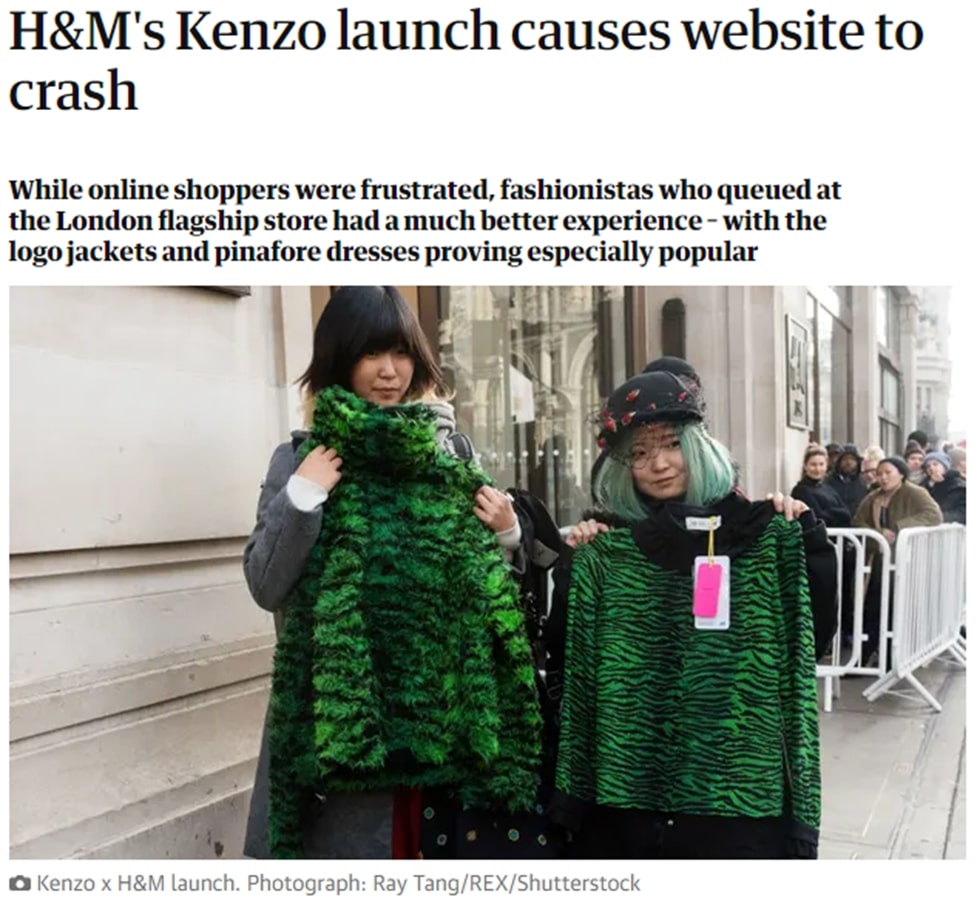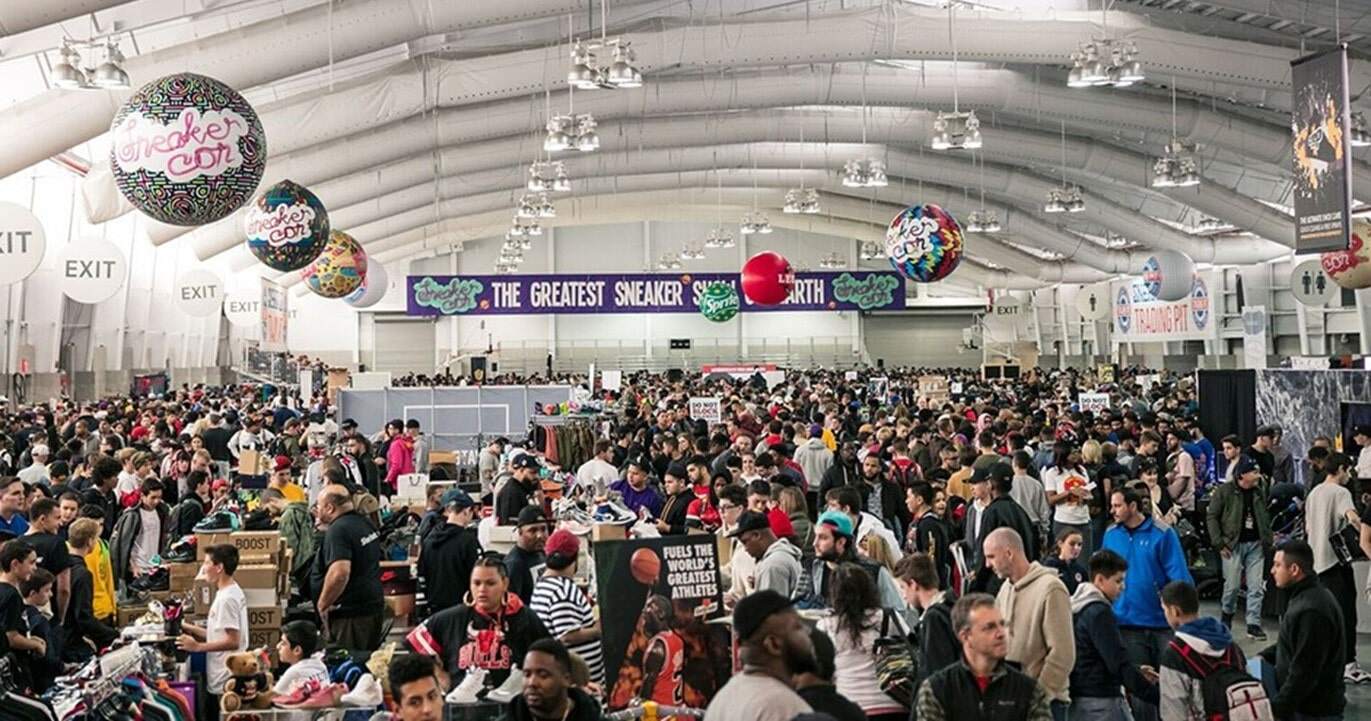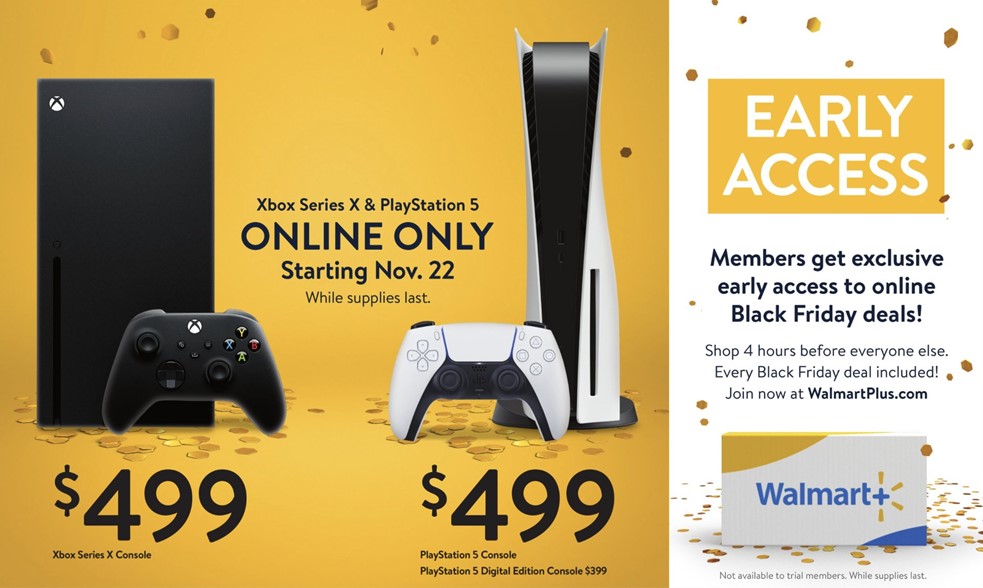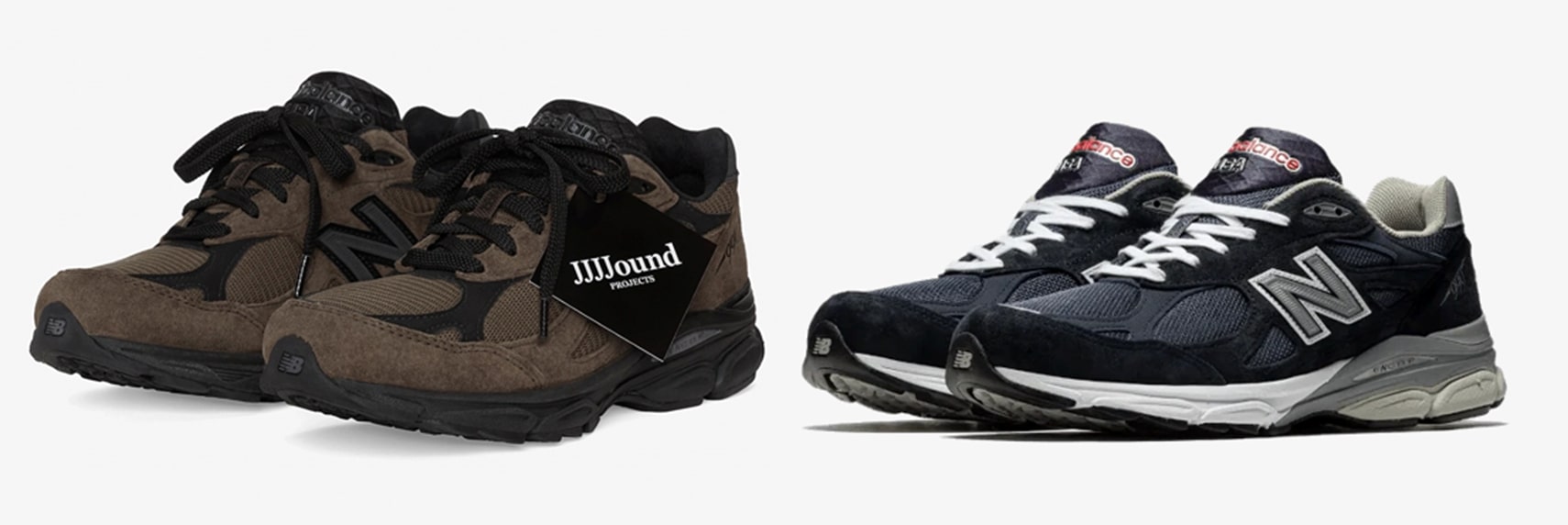The 5 powerful brand benefits of product drop marketing

Major brands across industries are embracing product drop marketing. But why? Discover the 5 key benefits driving brands towards a product drop sales model. Plus, learn how product drops helped double global interest in New Balance sneakers, enabled Sony to generate hype around PS5s almost two years after the console’s launch, and how major brands are generating Black Friday-level hype and queues without discounting their products.
The product drop model is taking online retail by storm. It’s grown far beyond its origins in streetwear and sneaker culture and is today being embraced by brands from McDonald’s to GAP to Twitter to Prada.
But why are major brands across industries rolling out product drop strategies? How do product drops relate to ecommerce marketing? And what are the benefits of product drops for brands?
We’ll answer all these questions and more in this article. But first, what is a product drop?
A product drop is the release of a product that’s scarce in availability or scarce in quantity. This means it’s either a time-limited product release, or one where supply is intentionally low.
Product drops typically take this second form of limited supply. Examples of this include sneakers dropping in a limited-edition colorway, one-off brand collaborations, or merchandise connected to an event or album release.
When a brand engages in product drop marketing, they’ll often release limited-edition versions of products they already produce, or have another brand or public figure create a twist on a core product to generate new interest. These tweaks to core products could be as simple as a new color, the incorporation of another logo, a change in the material, or the addition of a unique graphic.
Brands that adopt a product drop strategy or business model repeat this many times, dropping or restocking products consistently—every week, two weeks, or month.
So, what are the benefits of product drop marketing?
- Building brand awareness, affinity & community
- Shifting scarcity marketing from discounts to drops
- Cultivating brand relationships with loyalty programs
- Improving the customer experience with anticipation, hype & engagement
- Generating hype around your brand & core products
Product drops may technically be a sales delivery method, but like flash sales, its major benefits lie in its marketing value. Product drops create unique opportunities for brand awareness, engagement, and community building.
The scarcity marketing behind drops helps transform your products from something you wish customers would buy into something your customers wish they could buy.
This also means product drops transform your brand communications from something you want customers to engage with into something your customers want to engage with.
In this way, successful product drops are a form of organic marketing. They create speculation, discussion, hype, and anticipation. When a customer is interested in a product drop, they get closer to and learn more about your brand, which is why 67% of consumers report increased brand affinity after product drops.
Product drops are also perhaps the only sales delivery or marketing method that’s produced a subculture.
Drop culture is a term used to describe the thinking, behavior, and community of brands and customers that embrace product drops.
So how can a sales delivery method also be an organic marketing tool and a subculture?
There are a few reasons, but one of the most important is that product drops help transform sales into entertainment.
Product drops let retail marketers act like musicians and movie studios. With product drops, marketers can regularly tease new products to get customers excited, engage in unexpected brand collaborations to tap into new audiences, and drip feed customers and journalists content for speculation and conversation.
No one talks about buying the same plain white t-shirt H&M has sold for decades. But when H&M does a limited-edition collaboration with French Luxury brand Kenzo, journalists publish headlines, fans line up, and demand is so high it crashes their website.
RELATED: Everything You Need to Know About Product Drops: Strategies, Benefits & Examples

Product drops are about the new and novel. About tapping into anticipation and excitement. About creating a brand moment.
And for brands and industries that leverage this technique successfully, they’re about creating communities.
Product drop communities are most prominent in the sneaker world, where events like Sneaker Con attract thousands of guests and content like Complex’s Sneaker Shopping videos get celebrity guests and millions of views.

Reddit’s r/sneakers has three million members who regularly discuss, share, and celebrate sneakers. Compare that to Reddit’s r/kettles, which has just 36 members—the last post is from 8 months ago asking how to descale a kettle.
We’re not hating on kettles or anything, we’re just saying drop culture has helped turn the sneaker industry into an 80-billion-dollar behemoth with more engaged customers than almost any other product category.
This is because sneaker culture is not just buying and selling shoes—it’s entertainment. It has the exciting elements of competition (Adidas vs. Nike), brand and celebrity collaborations, and an unending stream of drops that allow brands to build awareness, boost affinity, and foster community.
Product drop marketing is a powerful tool. It enables you to create brand moments and engage in collaborations to capture the attention and affinity of new and existing customers alike. And when practiced consistently, it creates conditions in which brand communities can grow and flourish.
Get a free interactive checklist for successful product drops

The second key benefit of product drop marketing is it enables you to leverage the power of scarcity marketing without discounting products and de-valuing your brand.
Scarcity marketing is often associated with flash sales, drawing customers in with language like “get this 40% discount while it lasts”. It’s these deals—and their scarcity—which inspire long lines outside stores on Black Friday every year.
Successful product drops have similar scarcity marketing effects to these flash sales. They tap into customers’ sense of urgency and fear of missing out.
But the difference with product drops and limited inventory scarcity is you can sell items at full retail price while still attracting customers that’re willing to line up and feel like they’re nabbing a great deal.
In one survey, more than half the respondents (54%) reported they’re willing to wait in line for a product drop.
Another survey found 45% of consumers are interested in product drops specifically because they value access to products that are difficult to obtain.
RELATED: 6 Common Product Drop Challenges & How to Overcome Them
Shifting your scarcity marketing from discounts to drops benefits not just your margins, it also maintains your brand image and reputation.
Offering 40% discounts is a great way to clear out inventory, but it tells customers people weren’t willing to buy products at full price. In some ways, this is the inverse of social proof, and de-values your brand.
This is why luxury brands like Louis Vuitton, Tiffany & Co., and Chanel never go on sale—to maintain their image of exclusivity and high quality.
But it’s not just luxury brands that avoid sales. Newer brands that operate on a product drop model, like SKIMS and Supreme, also rarely run sales. They generate hype with drops instead of discounts. And with low supply, they have little need to clear out unsold inventory through big sales.

You can see the benefits of scarcity of inventory in the examples we’ve mentioned above, but they also apply to limited supply restocks.
RELATED: 7 Simple Scarcity Marketing Strategies to Supercharge Ecommerce
Whether intentionally or not, products like Sony’s PS5s and AMD’s graphics cards have been incredibly difficult to buy for the past two years. Both companies restock these products when they have supply, making these restocks regular events that have similar scarcity marketing and anticipation effects to product drops.
To be clear, the release of Sony’s PS5 was a product launch, not a product drop. This means that—unlike a limited-edition sneaker Nike might drop once and never release again—the PS5 will continue to be produced until demand is satisfied, or until the launch of the PS6.
But Sony’s struggle to keep PS5s in stock and their model of regular limited restocks means they reap many of the same benefits as brands that engage in product drops.
You can see this scarcity marketing in Sony’s PS5 registration page below. Customers are offered the chance to register for an opportunity to purchase a PS5.

Despite launching almost two years ago, there are dozens of headlines posted weekly about PS5 restocks and availability. A Twitter account dedicated to PS5 stock alerts has 1.1 million followers. These restocks see thousands queue in virtual waiting rooms.

Customers love getting a good deal. And the scarcity of PS5s means customers who get their hands on one feel like they’re getting a good deal despite paying full retail price.
Shifting from discounts to drops helps many brands achieve satisfied and engaged customers without sacrificing their margins.
76% of customers who take part in product drops are very or extremely satisfied, because drops replace customers’ shopping guilt with a feeling of shopping glee.
Product drops let customers feel like they’ve won a prize or gotten away with something they shouldn’t have, all while still paying full retail price.
Hear from Queue-it's VP of Marketing Pat Spring how brands across industries are shifting from discounts to product drops in this clip from our webinar Scarcity & Hype: The Secrets for a Successful Black Friday.
The product drop trend is closely related to another fast-growing ecommerce trend: loyalty programs.
Ecommerce loyalty programs are a way of formalizing and strengthening relationships between brands and consumers. They aim to deepen brand trust, expand brand touchpoints, enable personalization, and nurture loyalty.
To achieve these benefits, loyalty programs typically offer rewards, discounts, and other exclusive benefits in exchange for repeat purchases, personal information, and/or recurring payments.
Amazon Prime is a prime example (excuse the pun). With probably the largest retail subscription base out of any brand, Amazon not only gets millions in monthly revenue from subscription fees, they’re also the first place Prime subscribers turn to when looking to buy a product. It’s a win-win for Amazon.
One survey found 70% of consumers spend more with brands when they’re part of a loyalty, member, or subscription program.
RELATED: Ecommerce Loyalty Programs: How To Keep Customers Coming Back for More
The key question brands face when looking to create a successful loyalty program is: how can we deliver enough value to customers to make a relationship worthwhile?
Tactics like giving newsletter subscribers 10% off their first order are a start, but these do little to ensure continued engagement with the brand.
The product drop model is highly conducive to getting loyalty program sign-ups, as it creates more engagement opportunities and heightens competition and demand for products.
When there’s competition for goods, customers will do anything they can for an advantage. That’s where loyalty programs come in. You can use product drops to nurture loyalty and form commerce relationships by:
- Dropping products that people can only purchase on your mobile app (this is Nike’s strategy)
- Offering early access to paid subscribers (this is Walmart and Best Buy’s strategy)
- Developing invite-only product drops and private sales for members
- Creating a pre-sale sign-up form or waitlist for your drop to gather email addresses
- Delivering first notifications of restocks to newsletter subscribers (SKIMS does this)
- Reserving products for paid members or high-value customers

Exclusivity is a powerful thing. When used right, the exclusivity of product drops can be leveraged to incentivize stronger connections and commitments between customers and your brand.
Forming these commerce relationships makes customers more likely to spend more with your brand and gives you valuable communication channels to nurture their loyalty.
RELATED: 79 Staggering Statistics That Show the Power of Loyalty Programs
Oops, you dropped something. Here you go: it’s your free interactive product drop checklist

Alongside the scarcity marketing value of product drops, anticipation psychology drives much of the product drop hype cycle and success of brands with this model.
Product drops take your brand beyond a traditional store where customers just walk in and shop at their convenience. Instead, customers must work and wait for your products. Your product announcements become news headlines and fodder for social media chatter. People get excited about your events.
In short, drops let you build hype and anticipation around your products. And while brands like Apple do this only once or twice a year while announcing a new iPhone or MacBook, brands that are successful with a drop model have this cycle happening constantly.
Improving the customer experience by making products hard to get may seem counterintuitive. But for non-essential items designed to bring customers joy, it isn’t.
Remember the statistic about waiting in line for product drops? Most consumers are happy to do it. Plus, almost half of consumers are interested in drops specifically because the products are hard to get.
It turns out the adage, “Nothing worth having comes easy” is more than just folk wisdom. It’s an effect of the psychology of anticipation.
Anticipation psychology research has found positive anticipation:
- Improves wellbeing and creates excitement
- Increases sensitivity to rewards
- Creates stronger memories surrounding events
RELATED: The Power of Anticipation Psychology & How to Use it for Ecommerce Marketing
Another psychological effect at play in product drops is effort justification. When we do something difficult, we want to believe the difficulty was worthwhile. And so, to justify the effort put in, we tend to attribute more value to things we’ve worked for.
These findings explain why product drops work so well to create excitement and boost brand affinity—because they make customers work to buy products and create positive anticipation by delaying gratification.
By drawing the purchase experience out over a longer period, you draw out customers’ anticipation. This helps them build more excitement around your brand, but it also means when they finally get their hands on products, they’ll be more likely to enjoy them, more likely to value them, and more likely to remember their purchase.

One of the key perks of the product drop model is its benefits extend far beyond the single product drop or brand collaboration you’re engaging in. For many brands, product drops boost sales of core products.
By building hype around your brand, creating headlines about it, and tapping into scarcity marketing and anticipation psychology, you elevate overall brand awareness and affinity, and these benefits flow back to your core product range.
The recent success of New Balance is a perfect example.
In 2018, New Balance’s Senior Manager of Global Collaborations and Energy Joe Grondin and his supervisor got the green light to pursue the brand’s first dedicated collaboration strategy.
In the years that’ve passed, this strategy has taken the brand from dad fashion to high fashion.
Google Trends shows interest in New Balance more than doubled year over year in the first half of 2022.
Following strategic collaborations with underground “it” brands like Aimé Leon Dore (ALD) and JJJJound, interest in old New Balance silhouettes like the 550 and 990 boomed.

These collaborative drops sold out quickly. But shortly after these product drops, something else happened. The original shoes the collaborations were based on sold out too.
Customers who missed out on the ALD x New Balance 550 and the JJJJound x New Balance 990 realized the original versions of the sneakers, which looked very similar, were still available—at least for a moment.

Fast forward to 2022, and these core New Balance shoes are some of the hottest sneakers of the year. Sold out everywhere, restocks of the 550 silhouette see virtual queues of over 70,000, according to Glamour Magazine.
“We’ve never seen anything like it,” said Joe Grondin, speaking to the renewed interest in New Balance.
Beyond specific high demand sneaker silhouettes, New Balance’s product drops and collaborations seem to have sparked something of a brand renaissance, launching it into the realms of hype and high fashion.
Today, there are dozens of articles discussing and analyzing New Balance’s rise to mainstream fashion and endless paparazzi pics of everyone from Leonardo DiCaprio to Timothée Chalamet to Hailey Bieber wearing the shoes.
New Balance’s story shows brand collaboration product drops are rarely just about the collaboration—they’re about the brands. Likewise, they’re rarely about the sales of the limited-edition products—they’re about sales of core products.
RELATED: 23 Successful Product Drop & Brand Collaboration Examples for Inspiration

Source: Glamour Magazine
Leveraging the benefits of product drop marketing
It’s no wonder the product drop model is spreading beyond the world of sneakers and streetwear. Product drop marketing has massive brand potential, and many brands are showing just how powerful the benefits of product drops can be.
In recent years, we’ve seen a McDonald’s collaboration with Travis Scott lead to ingredients shortages, an IKEA collaboration with Virgil Abloh create massive queues and hype, and social media platforms from Instagram to Twitter incorporating product drop functionality into their apps.
Every brand can take inspiration from product drop marketing and the business model that’s created drop culture. Brand collaborations, limited-release items, tweaks to core products, regular product restocks, tapping into anticipation psychology and scarcity marketing—these strategies are available to all retailers.
And if you’re successful with your product drop marketing, you’ll reap these 5 key benefits:
- Build brand awareness, affinity & community
- Shift scarcity marketing from discounts to drops
- Nurture loyalty & form commerce relationships
- Improve the customer experience with anticipation, hype & engagement
- Generate hype around your brand & core products